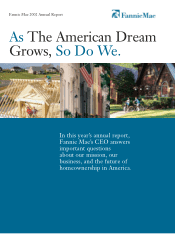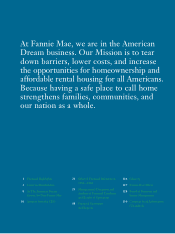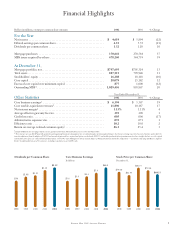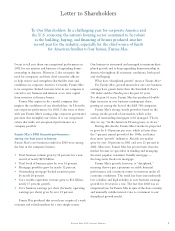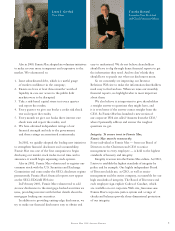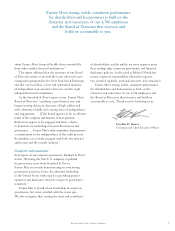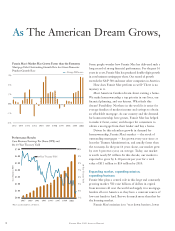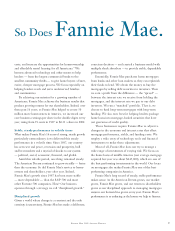Fannie Mae 2002 Annual Report Download - page 5
Download and view the complete annual report
Please find page 5 of the 2002 Fannie Mae annual report below. You can navigate through the pages in the report by either clicking on the pages listed below, or by using the keyword search tool below to find specific information within the annual report.
3
FANNIE MAE 2002 ANNUAL REPORT
Letter to Shareholders
To Our Shareholders: In a challenging year for corporate America and
the U.S. economy, the nation’s housing sector continued to be robust
as the building, buying, and financing of homes produced another
record year for the industry, especially for the chief source of funds
for American families to buy homes, Fannie Mae.
I want to tell you about our exceptional performance in
2002 for our mission and business of expanding home-
ownership in America. However, I also recognize the
need for companies and their chief executive officers
to help restore and strengthen shareholder trust and
confidence in corporate America. Certainly, Fannie Mae
is no exception. Indeed, investor trust in our company is
crucial to our business and mission as we raise capital
from investors to finance homes.
Fannie Mae aspires to be a model company that
inspires the confidence of our shareholders. As I describe
our corporate performance for 2002, I also want to share
with you Fannie Mae’s cutting-edge corporate governance
practices that exemplify our values. It is our exceptional
values that make our exceptional performance as a
company possible.
Fannie Mae’s 2002 financial performance:
among our best years in history
Fannie Mae’s core business results for 2002 were among
the best in the company’s history.
•Total business volume grew by 38 percent for a new
record of nearly $850 billion.
•Total book of business grew by over 16 percent.
•Mortgage portfolio grew by nearly 12 percent.
•Outstanding mortgage-backed securities grew
by nearly 20 percent.
•Core taxable-equivalent revenue grew to $12 billion,
nearly 17 percent growth.
•Core business earnings per share (formerly, operating
earnings per share) grew by over 21 percent.
Fannie Mae produced this record year in spite of a weak
economy and volatile markets for a very simple reason:
Our business is structured and managed to maintain disci-
plined growth and to keep expanding homeownership in
America throughout all economic conditions, both good
and challenging.
What does “disciplined growth” mean at Fannie Mae?
For Fannie Mae, growth means that our core business
earnings have grown faster than the Standard & Poor’s
500 index and the Nasdaq over the past 16 years.
For the past 16 years, Fannie Mae has produced double-
digit increases in core business earnings per share,
putting us among the best of the S&P 500 companies.
Fannie Mae’s strong, steady growth is based on the
strong, steady growth of our market, which is the
stock of outstanding mortgages to be managed. That is
why we say, “As the American Dream grows, so do we.”
During this decade, Fannie Mae’s market is projected
to grow by 8-10 percent per year, which is faster than
the 7 percent annual growth of the 1990s, and faster
than most “growth” industries. Already our market
grew by over 10 percent in 2001 and over 12 percent in
2002. Moreover, Fannie Mae has grown faster than the
market because we specialize in funding and managing
the most popular, consumer friendly mortgage —
the long-term, fixed-rate mortgage.
Fannie Mae’s growth, however, is “disciplined,”
meaning that we put a premium on stable financial
performance and consistent return to investors under all
economic conditions. The result has been extraordinarily
low volatility and high stability in core business earnings
growth for 16 years in a row. The fact that 2002 was an
exceptional year for Fannie Mae in spite of the slow economy
and unusually volatile interest rates is a testament to our
disciplined growth model.

